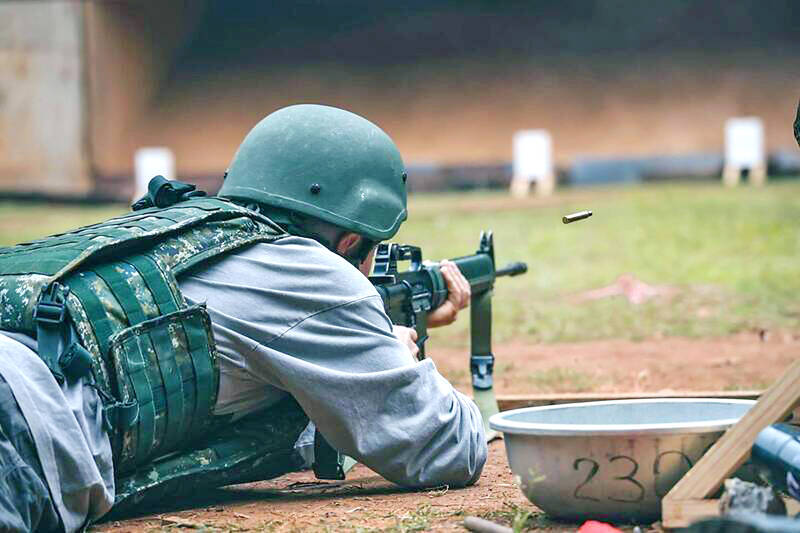Taiwan expects to begin mass production of the nation’s first domestically developed tungsten-core rifle ammunition next year, a high-ranking defense official said yesterday.
On condition of anonymity, the official said the Ministry of National Defense’s Armaments Bureau has completed a series of tests and is preparing to deliver prototype rounds to the army for testing.
The bureau is confident the new ammunition would meet military expectations and be included in next year’s general budget, paving the way for mass production, the official said.

Photo courtesy of the Ministry of National Defense
The tungsten-core round is designed to penetrate the standard-issue body armor worn by the Chinese People’s Liberation Army Ground Force, they added.
The prototype achieved a 100 percent success rate in defeating commercial off-the-shelf body armor believed to match the performance of Chinese equipment, the source said.
The introduction of armor-piercing rifle rounds would significantly enhance the lethality of Taiwan’s infantry forces, they added.
Army Chief of Staff Lieutenant General Chen Chien-yi (陳建義) told lawmakers late last year that while Taiwan’s military had not ruled out adopting a 6.8mm rifle cartridge — similar to that used by the US Army — there were concerns about the increased weight and logistical trade-offs of using heavier ammunition.
In March, the US Army began limited fielding of the SIG XM7 rifle, the winning design in the Next Generation Squad Weapon program. Chambered in 6.8x51mm Common Cartridge, the XM7 was first deployed to the 101st Airborne Division.
The US Army has said that a significantly more powerful service cartridge is necessary to counter advances in body armor technology, extend the effective range of infantry squads and provide a decisive advantage in small-arms lethality.
However, Chen said that the 100,000 rifles produced by the US represent a minuscule volume and that most NATO members continue to rely on the combat-proven 5.56x45mm cartridge as their standard rifle ammunition.
While the US-designed 6.8x51mm round offers greater firepower, it comes with trade-offs — including heavier loads and a lower ammunition count per soldier, Chen said.
The army estimated that adopting the US bullet would increase standard infantry loadout by 5kg, he said, adding that combat units were evaluating whether an operational need for a new cartridge exists.
The ministry said that a 6.8mm rifle prototype has been developed and is being tested by the armed forces.
In other developments, the ministry said in a report to the legislature last week that the navy expects to receive 400 RGM-84L-4 Harpoon Block II (U) Surface-Launched Missiles and 100 Harpoon Coastal Defense System launcher transporter units by 2028.
The acquisition of the surface-launched Harpoon variant is aimed at bolstering coastal defense capabilities and the kill probability of Taiwanese weapons against Chinese naval formations.
The US is scheduled to deliver five launcher units and one radar vehicle by the end of next month, with a total of 32 launchers to be delivered by the end of next year, the report said.
While the Harpoon Block II missile has a nominal range of 67 nautical miles (124.1km), a senior Taiwanese naval officer told lawmakers that the upgraded Block II (U) variant purchased by the military includes extended-range capabilities.

TRAFFIC SAFETY RULES: A positive result in a drug test would result in a two-year license suspension for the driver and vehicle, and a fine of up to NT$180,000 The Ministry of Transportation and Communications is to authorize police to conduct roadside saliva tests by the end of the year to deter people from driving while under the influence of narcotics, it said yesterday. The ministry last month unveiled a draft of amended regulations governing traffic safety rules and penalties, which included provisions empowering police to conduct mandatory saliva tests on drivers. While currently rules authorize police to use oral fluid testing kits for signs of drug use, they do not establish penalties for noncompliance or operating procedures for officers to follow, the ministry said. The proposed changes to the regulations require

Taipei, New Taipei City, Keelung and Taoyuan would issue a decision at 8pm on whether to cancel work and school tomorrow due to forecasted heavy rain, Keelung Mayor Hsieh Kuo-liang (謝國樑) said today. Hsieh told reporters that absent some pressing reason, the four northern cities would announce the decision jointly at 8pm. Keelung is expected to receive between 300mm and 490mm of rain in the period from 2pm today through 2pm tomorrow, Central Weather Administration data showed. Keelung City Government regulations stipulate that school and work can be canceled if rain totals in mountainous or low-elevation areas are forecast to exceed 350mm in

EVA Airways president Sun Chia-ming (孫嘉明) and other senior executives yesterday bowed in apology over the death of a flight attendant, saying the company has begun improving its health-reporting, review and work coordination mechanisms. “We promise to handle this matter with the utmost responsibility to ensure safer and healthier working conditions for all EVA Air employees,” Sun said. The flight attendant, a woman surnamed Sun (孫), died on Friday last week of undisclosed causes shortly after returning from a work assignment in Milan, Italy, the airline said. Chinese-language media reported that the woman fell ill working on a Taipei-to-Milan flight on Sept. 22

1.4nm WAFERS: While TSMC is gearing up to expand its overseas production, it would also continue to invest in Taiwan, company chairman and CEO C.C. Wei said Taiwan Semiconductor Manufacturing Co (TSMC) has applied for permission to construct a new plant in the Central Taiwan Science Park (中部科學園區), which it would use for the production of new high-speed wafers, the National Science and Technology Council said yesterday. The council, which supervises three major science parks in Taiwan, confirmed that the Central Taiwan Science Park Bureau had received an application on Friday from TSMC, the world’s largest contract chipmaker, to commence work on the new A14 fab. A14 technology, a 1.4 nanometer (nm) process, is designed to drive artificial intelligence transformation by enabling faster computing and greater power